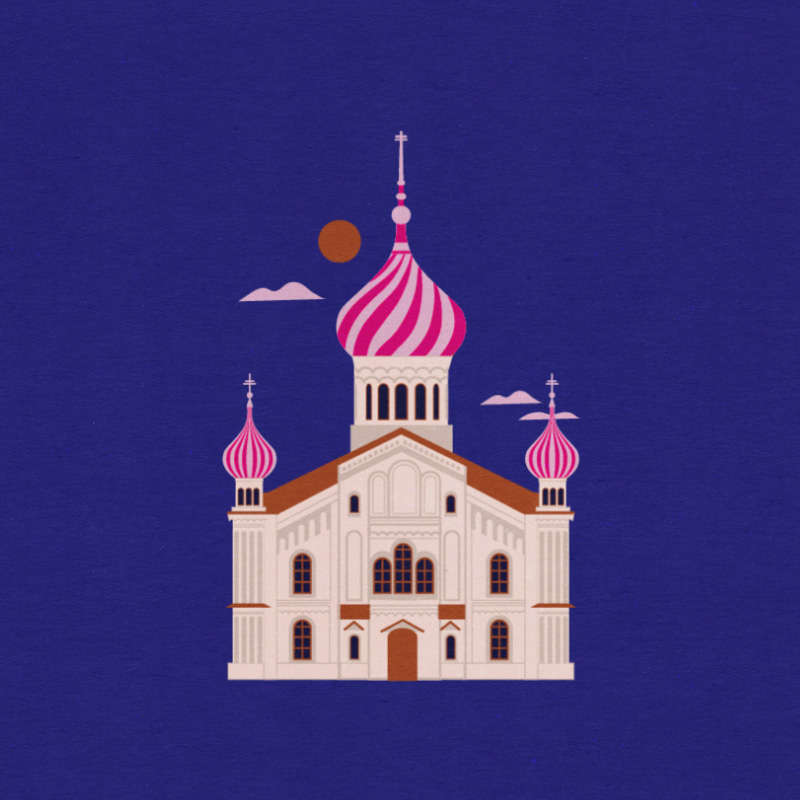History of the Lithuanian Orthodox Cathedral
> BACK TO 100 STORIESDifferent religious communities always lived together in a friendly way in the Grand Duchy of Lithuania. This is also reflected in the architecture of the capital, Vilnius: Catholic, Protestant, Jewish, and Orthodox houses of worship can be seen close together here. Moreover, Vilnius Old Town is even divided into Catholic and Orthodox parts. If you go up from the Palace of the Grand Dukes of Lithuania towards the Town Hall Square, you will notice that the Orthodox churches are to the east (left) of this street, and the Catholic churches to the west (right). Such a division has an important symbolic meaning: the Orthodox churches are in the east, because the Orthodox Church is also called the Eastern Church, and the Catholics belong to the Western Church. However, it is important to keep in mind that both Eastern and Western Churches are Christian.
The Orthodox Christians are the second largest Christian community in Lithuania. The first Orthodox churches in the Grand Duchy of Lithuania were built in the fourteenth century in Vilnius and Trakai. Orthodoxy spread because of romantic and political relationships in the nobility – the dukes of the Grand Duchy of Lithuania often married Russian duchesses and didn’t force them to renounce Orthodoxy. The most famous Orthodox Christians of Lithuanian origins are Vaišelga, the Orthodox monk and the son of Mindaugas, the King of the Grand Duchy of Lithuania, and Daumantas, the Duke of Nalšia and one of Mindaugas’ murderers, who became an Orthodox saint.
The Cathedral of the Theotokos in the Old Town stands out from the other churches of Vilnius. Algirdas, the Grand Duke of Lithuania, built this house of worship for his wife Uliana of Tver in 1346. It became an Orthodox Cathedral at the beginning of the fifteenth century, where services were held by the metropolitan bishop. The residence of the local metropolitan bishop across the street is a luxury hotel.
The Cathedral of the Theotokos is also important because of its architecture. Most Orthodox churches are decorated with domes, which are called “onions” due to their shape, but the Cathedral of the Theotokos doesn’t have one. The cathedral is built in the Gothic style, more precisely, it is classified as a “defensive” Gothic church. Ordinary Gothic churches are light and graceful, extending upwards, whilst the corners of “defensive” Gothic churches are supported by towers and their walls are thick and massive. The nearby Roman Catholic Church dedicated to St. Francis of Assisi also has “defensive" Gothic features.
There is an iconostasis, a wall of icons and religious paintings, in the center of each Orthodox church. Orthodox Christians see the icons as a window into the sacred reality, so they not only burn candles in front of them, but also bow and kiss them while praying. Almost all of the icons in the Cathedral of the Theotokos were painted in the nineteenth century, and their style is closer to Western painting than to that of traditional icons. In addition, most of the icons depict local Orthodox saints associated with the Grand Duchy of Lithuania.
Like most Orthodox and Catholic churches in Vilnius, the Cathedral of the Theotokos has been rebuilt many times. The church suffered most during the fires and wars of the seventeenth and eighteenth centuries. In the past, the restoration of churches was not focused on preserving their initial appearance and original style, therefore the cathedral was restored not in the Gothic style, but in a much more decorative Baroque style. At one time, the Cathedral of the Theotokos was even handed over to Vilnius University, which turned into an Anatomical Theater where university researchers performed public autopsies of corpses – a form of anatomy classes for students and curious citizens.
The cathedral was restored to the Orthodox community after the uprising of 1863, which was suppressed in Lithuania by the occupying army of the Russian Empire. The church was rebuilt according to the design of Russian architects Nikolai Chiagin and Alexander Ryazanov: new partitions were demolished and old Gothic columns and surviving vaults were uncovered. The original form of the building has now been restored, only a light dome that was not present in the original building has been installed, and the external walls have been plastered – more recently, the plaster has been removed in several places to uncover the old masonry walls.

